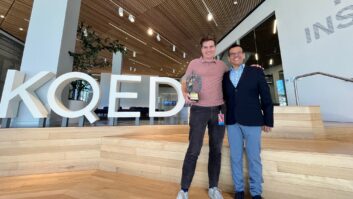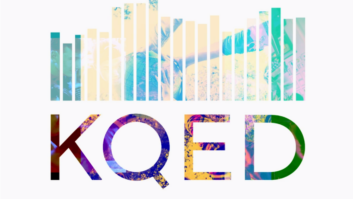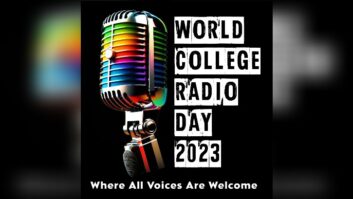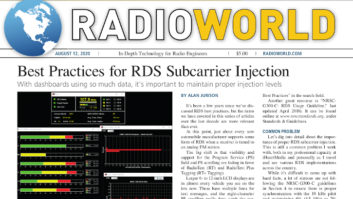
FEMA IPAWS Program Manager Al Kenyon, left, was a panelist while NAB Associate General Counsel Larry Walke helped facilitate ‘Radio Regulatory Jeopardy.’
Credit: Photo by Jim Peck Executives and engineers know the industry is at a crossroads. To retain radio’s competitiveness, they want to improve the quality of content, and place it on as many platforms as possible.
That was the theme of many conversations at the fall Radio Show in Orlando, Fla. — and it seems especially important as radio faces more challengers in the car, where the medium has dominated listening for decades.
The next five years will be critical as the digital dashboard takes hold, speakers predicted. Will radio rise to the challenge? How can it be a part of the connected car discussion and not swept along by decisions made in the automotive world?
Going digital in all forms, be that via streaming, HD Radio or other platforms, is a way to keep radio competitive and mobile, according to some group executives who attended.
Radio executives reminded attendees — as well as their new competitors in Internet audio — that, for all the hype about digital, traditional broadcast radio still dominates U.S. audio listening. Yet the industry can’t take that position for granted, they said. Several talked about the need to get rid of so-called “crappy” ads and long stopsets. Executives also jumped on a “live and local” theme, decrying the use of voice-tracking, thus verbalizing a criticism that many have aimed at the radio industry over the years.
Here are news highlights from the Radio Show and immediately afterwards.
FIELD: ‘THE FUTURE OF RADIO IS BRIGHT’
While digital media entrants tend to paint radio as a dinosaur, Entercom Communications President/CEO David Field says traditional radio is anything but.
“The sky is not falling for broadcast radio. The ecosystem of radio is enhanced by competition. The success of one form of radio does not necessarily come at the expense of another,” said Field. He spoke at the Radio and Internet Newsletter Summit preceding the Radio Show.
Field says traditional radio continues to innovate and that listeners remain attached to their local stations. He cited the recently announced Cumulus-Rdio partnership as an example of “major” innovation, as well as the Sprint-NextRadio deal on the FM chip. Further, roughly half of new cars will have built-in HD Radio receivers or technology by 2015, according to Field.
The future of broadcast radio is bright, said Field, mentioning the medium’s “massive” reach. He says traditional broadcast radio is undervalued and that if it continues to innovate, it will grow. “We are living in the golden age of radio. Its best days lie ahead.”
RADIO ‘DOMINATES’ TOTAL LISTENING
Field also noted a “massive” gap in percentage of listening share between traditional broadcast radio and Pandora. His criticism comes as Pandora opens more local sales offices in top media markets and cites listening data in advertising pitches that compete with broadcast radio and its streams.
The Entercom executive said Pandora’s claimed listening levels don’t quite add up.
Just after the show, Pandora released September audience estimates, saying its total share of U.S. radio listening for the month was 7.7 percent, up from 6.53 percent for the same period a year ago.
Field says Katz Media Group estimates Pandora’s share of total U.S. radio audience at closer to 4.4 percent, followed by other webcasters at 3.2 percent — while broadcast radio “dominates” audio listening at 92.4 percent.
Some of Pandora’s listeners leave their streams on all day, Field said. “They may be out — yet that listening counts.”
Broadcast radio has 20 times Pandora’s listening, he continued, noting that Arbitron data showed radio’s audience is 242 million.
Pandora claimed 72.7 million “active” listeners for the month of September, a 25 percent increase from a year ago.
IS APPLE ITUNES RADIO
A ‘PANDORA KILLER?’
Apple iTunes Radio launched just before the Radio Show. Many tech media outlets, like CNET, dubbed it a “Pandora killer.”
Asked to comment about the Apple product during the RAIN Summit, Pandora Automotive Business Development Director Geoff Snyder said, “We’re aware of what they’re doing.” He said Pandora, no stranger to competition, remains focused. “We’re not going to change course.”
Slacker Senior Vice President of Business Development Steve Cotter said, “We see it as a validation of what we knew six to eight years ago when this company started.”
The best content is “going to win,” predicted TuneIn Vice President of Programming Kevin Straley.
RAIN Publisher Kurt Hanson believes the launch will help the audio product category in general to grow. “Competition is good.”
According to a GroupM Next survey of Internet audio users, respondents said iTunes Radio is “probably” more integrated and easier to use than Spotify; and they either hated Apple products or loved them. In fact, 34 percent of Internet audio users said they’d switch to an Apple streaming radio service from their current favorite (Pandora, Spotify, iHeartRadio or Slacker) based on Apple’s brand name alone.
“This could be a game-changer, or not. We’ll see,” said the GroupM Next executives Steve Sherfy and Jesse Wolfersberger. GroupM Next is part of GroupM, a global media investment management organization.
IBiquity Digital President/CEO Bob Struble told Radio World, “I think iTunes Radio will be another brick in the wall of digital competition that we need to address. It’s part of a broad set of new technologies that compete with us in the car, and in the home.” He said it argues in favor of an upgrade to HD Radio “because people expect to have a certain set of features and services that cannot be delivered by analog radio. When you’re listening to iTunes Radio you’ll see album art. When I listen to analog radio I’m not going to see album art.”
‘VOICETRACKING IS DEAD.’
“Voicetracking is dead. It’s a waste.”
So said Alpha Broadcasting and L&L Broadcasting CEO Larry Wilson during a Radio Show discussion by group executives about radio’s future. He said stations need to be live and local to succeed, a sentiment echoed by several of his fellow panelists.
NRG Media President/CEO Mary Quass agreed. “We’ve got to get people energized into the business. We need live overnight guys again.”
Asked whether radio’s ability to recover from the recession is hampered by the emergence of Apple iTunes Radio, Connoisseur Media’s Jeff Warshaw said, “While any competition is a concern, we think one of the things that potentially insulates radio is having a live presence.” That relationship with listeners is not easy to replicate, he said.
Wilson, who said he was an early adopter of Pandora, described the service as background music. “There’s not a mic that opens and someone entertains and informs you,” as traditional radio does.
A common theme among the executives, however, was that radio can’t sit on its laurels but must figure out how to air compelling content without boring ads that turn off listeners.
Wilson said that while the industry gets “caught up in talking about the digital age, we’re still terrestrial stations,” and most revenue still comes from analog signals. “We’re letting the product go downhill. We’re running crappy ads. The commercials have got to be compelling.”
As for radio’s competition from online audio, Cumulus in particular sees the audio universe as expanding. Explaining the company’s recent deal with Rdio, Cumulus Chairman/CEO Lew Dickey said, “We’re thinking of Rdio as a complement to our business. We want to be able to play across the entire audio ecosystem.”
‘FRANKEN FM’
DAYS NUMBERED
The days are numbered for so-called “Franken FMs,” those low-power TV stations operating on analog audio carriers of TV Channel 6 signals at 87.7 and 87.9 MHz.
All analog LPTV stations, including those essentially operating as radio stations, have a limited shelf life; they’re due to soon sunset. Analog LPTVs or TV translators operating on Channels 2 to 51 must end analog operation and convert to digital by Sept. 1, 2015.
The existence of a sunset date is probably why the FCC has avoided addressing concerns of radio broadcasters about whether these “Franken FMs” are permissible, according to Scott Flick, partner in Pillsbury Winthrop Shaw Pittman. Some radio stations, especially those at the lower end of the FM dial, complain that the LPTV “radio” stations cause interference.
“It’s a problem that that’s ultimately going to solve itself,” said Flick during a “Regulatory Jeopardy” panel. He thinks some LPTV operators might seek a waiver to extend that deadline, but they “would need to meet a high hurdle” to get a waiver.
RADIO CONNECTED CAR
GROUP FLOATED
As automakers and manufacturers of infotainment systems build the so-called “digital-dashboard,” radio should make sure broadcasters have their say.
So argues Jacobs Media President Fred Jacobs. He floated the idea of an industry consortium to protect radio’s place in the dash. “Radio needs a voice” in connected car discussions, he told a room full of attendees at a session in Orlando.
“We’re hoping this gets some lift and becomes a reality,” Jacobs told Radio World afterwards.
Jacobs Media and Strategy Analytics project there will be 140 million connected cars on the road globally by 2017. The companies said that as new infotainment systems come online, consumers can be confused about all the options available to them.
Fred Jacobs and Roger Lanctot, associate director of Strategy Analytics’ Global Automotive Practice, showed video clips of consumers struggling to turn on the radio and tune stations on a variety of in-dash big-screen infotainment systems. Jacobs and Lanctot urge broadcasters to test-drive connected cars and let OEMs know that radio wants to be a part of the connected car’s future.
Another takeaway of the session: “Rethink HD Radio,” Jacobs said. “Most OEMs believe the technology is a major player in the connected car, especially because of the big data pipe.”
Shortly after the show, Ford announced it had acquired Livio, which makes products and software tools to support smartphone/car connectivity. Its products include Livio Keys, a software package that helps app and content partners work with OEMs for promotion and marketing in the car. Another, FM Traffic Button, involves software code that’s added to an embedded app on the in-dash display; no smartphone is required to feature traffic reports from Clear Channel’s Total Traffic Network.
The purchase allows Ford and Livio to share technologies, intellectual properties and engineering talent. Their stated goal is to work toward an industry standard for in-car connectivity and smartphone-to-vehicle communications.
CONNECTED CARS: GAME CHANGER
The so-called connected car is an unsettled frontier for the delivery of mobile services. Each automaker is using a different technology and user interface to deliver radio and other entertainment to new, big-screen displays, and this can be confusing for buyers.
Connectivity has become a major factor in car-buying decisions, and dealers spend a lot of time explaining the new systems to consumers, even after purchase. Executives from automotive, receiver and Internet audio services discussed the state of in-dash integration at the RAIN Conference.
Currently, a driver “connects” to a car using either an embedded in-dash solution or by tethering a smartphone to the vehicle, with the phone controlling action on the display. Research company eMarketer predicts there will be some 40 million “connected” cars by 2014, and calls coming advancements a “game changer.”
“Once everyone can hit a button in their car and turn on Pandora just like a local station, then we’ll see the impact to traditional radio,” GroupM Next executives Steve Sherfy and Jesse Wolfersberger predicted at the RAIN Summit.
Automakers and their suppliers say they are creating solutions for consumers to access entertainment the way they want to. Pioneer, for example, takes a technology — whether traditional broadcast, satellite radio, HD Radio or Internet radio — and develops a hardware or software interface, according to Ted Cardenas, vice president of marketing for Pioneer’s Car Electronics Division. With its aftermarket AppRadio service, Pioneer brings Pandora into the vehicle, too.
And what does it mean for Pandora to be “in the vehicle?”
Pandora Automotive Business Development Director Geoff Snyder says the service is available on approximately 100 car models. Other consumers listen via a phone connected to the vehicle by Bluetooth wireless or USB port. The Pandora app provides metadata to the radio display, and the “skip track,” “thumbs up” and “thumbs down” controls are transferred to the dash. Using the app makes it easier to control the display, “as opposed to someone using the Aux jack,” said Snyder.
Ford is in the process of launching its Ford AppLink in Europe and the Asia-Pacific region, according to Scott Burnell, the global lead for business development and partner management in Ford’s Developer Program,. Ford Sync with AppLink enables drivers to voice-activate apps from behind the wheel. The capability has been on some Ford models available in the U.S. since 2010.
AppLink is the ability to extend command and control of an app running on a mobile device to the human interface of the vehicle, he explained. “It’s the ability to take actions and habits you already have outside of the vehicle and extend those to the vehicle in a more appropriate way,” said Burnell, with buttons “mapped” to voice commands and some actions locked out for safety while the car is moving.
When planning products, how do companies take into account different consumer preferences, like those who don’t want to integrate their phone into the dash? “Maybe you’re not committed to handing over control to a smartphone,” said Cardenas. That’s why Pioneer’s AppRadio comes in two versions: with and without a CD player. However, noting that it’s been more than 20 years since CDs were introduced and cassette products are still being made, “the compact disc isn’t going away anytime soon,” he predicted.
HD RADIO RECEIVER
SALES NEAR 15 MILLION
The HD Radio rollout is still showing momentum, according to iBiquity Digital.
Digital receiver sales are approaching 15 million, and some 12 million of those are in new cars or are auto aftermarket units.
About 35 to 40 percent of new cars sold in the United States this year include HD Radio technology. Many of those automakers offer HD as standard across their vehicle lineups. Where the capability is not standard, it’s offered as part of an optional package or trim level on most premium or navigation radios.
Company President/CEO Bob Struble predicts penetration will rise to half of all new cars next year. “That growth rate, we think, is going to continue to rise into the foreseeable future.”
As the installed base of HD Radio receivers rapidly increases, so has listening to HD2/HD3/HD4 programming.
There are 1,475 multicast channels, according to Arbitron and iBiquity.
According to the latest spring 2013 Arbitron Radio audience estimates, more than 4 million people listen to an HD2, HD3 or HD4 channel over the air or online in an average week, an 11 percent increase over fall 2012 listening estimates. That’s an 11 percent increase over fall 2012 listening estimates, when 3.6 million listened to a multicast channel on-air or online. Arbitron considers both HD signals heard over-the-air and online to be “digital” and does not break them out separately.
Arbitron released the figures before it became “Nielsen Audio” after the show.
NEW APP, WEBSITE FOR HD RADIO
IBiquity Digital redesigned the HD Radio promotional website and launched an HD Radio Guide app for iOS and Android.
The redesigned hdradio.com simplifies the message to consumers and broadcasters “so they get the same experience of what HD Radio offers,” and not from solely a corporate perspective, iBiquity Senior Vice President Joe D’Angelo told Radio World. The site uses geo-location to list primary and multicast stations available in a user’s area.
The HD Radio Guide App is designed to help consumers learn about content and discover HD2/3/4 stations. Using the interactive station guide, consumers can connect with stations through SMS, phone and social media networks. The app includes a guide to receivers including “buy” links. To get the app, text APP to 25859 or download it through the iTunes App store or Google Play Android Market.
Separately, iBiquity partnered with Toyota to give away a 2013 Scion FR-S sports car equipped with an HD Radio receiver. Participants have until Oct. 29 to enter. U.S. residents can enter at hdradio.com, by downloading the HD Radio Guide App or by liking the HD Radio Facebook page.












